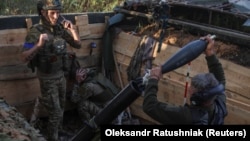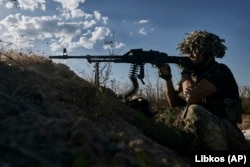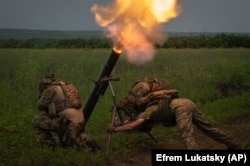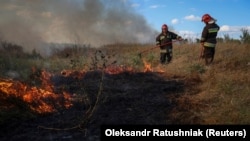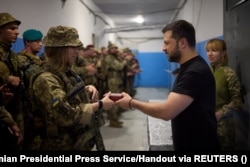The landscape between the Ukrainian villages of Robotyne and Verbove, in Ukraine's southern Zaporizhzhya region, is open and flat, rectangular farm fields now pocked with blackened artillery craters and lined by shrapnel-shredded trees that provide spotty cover. Scratched into the fields are rows of man-made trenches, tunnels, triangular concrete blocks called dragons' teeth, and an impossible number of anti-tank and anti-soldier land mines.
They're known as Surovikin Lines -- triple-layered defenses named for the Russian general who ordered their construction last year to thwart any Ukrainian effort to breach and try to outmaneuver Russian forces along a 1,200-kilometer front line.
Three months into its biggest counteroffensive of the 18-month-old Russian invasion, Ukraine is poised for a small but significant battlefield milestone near Orikhiv, in what many consider the main axis for the offensive: breaching the Surovikin Line.
Breaching the entire Surovikin Line outside Verbove would mean taking the village and expanding the pocket of control, or salient, that Ukrainian forces have carved out south of Robotyne, which was captured on August 28.
That could enable Ukrainian forces to threaten the key highway running from Orikhiv to Robotyne and then move south to Tokmak, a rail hub and road crossroads, which is 20 kilometers farther south through heavy fortifications. If they got to Tokmak, Ukrainian troops would then be close enough to strike Melitopol, a major river city another 50 kilometers farther south, and even threaten the coastal highway that Russian forces use to ferry people and supplies to the occupied Crimea Peninsula.
"The fact is that not only has the first line of [Russian] defense been crossed; at this moment there's also fighting ongoing inside the second line," said Yevhen Dikiy, a former officer with a Ukrainian military unit known as the Aidar Battalion.
"Russian command knows perfectly well what the cost of the question is now, what's at stake," he told Current Time, a Russian-language network run by RFE/RL in cooperation with VOA. "That's why the battle for Tokmak will be very hard. They will throw there all the reserves they have left. And, in essence, the question now is who will run out of reserves first. Because we're suffering quite serious losses in this offensive, but the Russian losses are also very significant."
"I agree with the thesis that the Russians are afraid of a breakthrough and lack of control in Zaporizhzhya," said Maciej Korowaj, a Polish military analyst and reserve lieutenant colonel in the Polish Army. "Ukraine fights according to the principle: hit, bend, starve," he said. "It is precisely this Ukrainian tactic that the Russians are afraid of and are trying to counteract."
In an interview with The Guardian published on September 2, Brigadier General Oleksandr Tarnavskiy, who commands Ukraine's Tavria grouping of forces, also claimed that troops had broken through the first lines of the Surovikin defenses near Robotyne.
"The enemy is [calling] up reserves, not only from Ukraine but also from Russia. But sooner or later, the Russians will run out of all the best soldiers. This will give us an impetus to attack more and faster," Tarnavskiy said. "Everything is ahead of us."
Reports of Ukrainian advances, or being on the verge of a breakthrough, have been corroborated by satellite imagery and open-source information. Russian military bloggers, some of whom are linked to military units or security agencies, also pointed to Ukrainian progress.
"The enemy is trying to assault between Verbove and Novoprokopivka," said one prominent Russian blogger, Yuriy Kotenok, in a Telegram post. "It's serious there. There is a threat of a breakthrough. Russia is committing reserves there. The line is held by highly resistant units. Unfortunately, they are not enough."
After months of regrouping and resupplying, on June 5 Ukraine launched a concentrated counteroffensive in three locations along the 1,200-kilometer front line: south of the town of Orikhiv, south of the settlement of Velyka Novosylka, and near the Donetsk region city of Bakhmut.
The Ukrainian effort was buoyed by hopes that legions of Western-supplied vehicles and weaponry -- U.S.-supplied Bradley armored personnel carriers, Leopard tanks and Marder infantry vehicles from Germany, and truck-mounted Caesar howitzers from France -- would help troops punch through Russian defenses.
In the days after the campaign got under way, however, Ukrainian units encountered the Surovikin Lines that Russia had spent months building. Since then, the tempo of progress has decreased substantially, with Ukrainian troops making slow, painstaking advances, village by village: "approximately 700–1,200 meters of progress every five days," according to one estimate.
About 100 kilometers northeast of Orikhiv, along the meandering Mokri Yaly River, it took Ukrainian forces more than three weeks to capture a pair of villages south of Velyka Novosylka. And in the vicinity of Orikhiv, which by some accounts has become the main thrust for the Ukrainian efforts, troops have advanced about 7 kilometers.
On September 4-5, Ukrainian forces appeared to have breached at least one of the Surovikin Lines on the western outskirts of Verbove, according to analysts from the Washington-based Institute for the Study of War and other open-source researchers.
In comments to Ukrainian TV on September 4, Colonel Oleksandr Shtupun, a spokesman for the Ukrainian Tavria grouping, said the second line of defense outside of Verbove was formidable but not as strong as the first lines.
Still, the snail's-pace advance has sparked frustration in some Western capitals, most notably in Washington, where the U.S. administration has provided nearly $70 billion in weaponry, equipment, and other humanitarian aid, according to the Kiel Institute for the World Economy, which has tracked aid donations to Ukraine.
Russia has sought to capitalize on that frustration. Responding to a reporter's question at a news conference alongside Turkish President Recep Tayyip Erdogan on September 4, President Vladimir Putin outright declared the Ukrainian campaign to be unsuccessful. "As for the Ukrainian counteroffensive spinning its wheels: It's not spinning; it's a failure," Putin said. "That's what it looks like today in any case."
Undermining Putin's assertion, however, were reports last week that Russian commanders had redeployed at least one major paratrooper unit -- the 76th Air Assault Brigade -- fighting around the northeast city of Kreminna to bolster troop strength north of Tokmak.
"This, combined with a lack of a coordinated and decisive response to [the] forming [of] a Ukrainian salient, appear to suggest a significant degradation of Russian combat potential in this sector," said Konrad Muzyka, a Polish-based defense analyst, said in a research note. "As a result, Ukrainian further gains are likely."
"Moscow will likely continue to attempt to degrade Ukrainian attacks in-depth and attrit its combat potential, forcing it to fight for every trench to the point when Ukrainians can no longer sustain the current tempo of attacks," he said.
"Redeployment of reserves of Russian airborne units is aimed at saturating the crooked front line," military analyst Korowaj said. "The Russian Army used up all operational and strategic reserves. If they want to save themselves, they have to take the best units from other directions," he said. "If the intensity of the fighting remains the same, theoretically, by the end of autumn, the Russian Army will have to let go of the Zaporizhzhya-Azov direction."
The "summer offensive is coming down to the balance of attrition over time, which side has more reserves, and who can better manage their combat power in a prolonged slugfest," Michael Kofman and Rob Lee, two veteran military experts, said in an analysis published on September 4.
"Ukraine's offensive neither is over, nor has it failed," they wrote.
White House spokesman John Kirby highlighted Ukrainian successes in comments to reporters on September 1. "We have noted over the last 72 hours or so some notable progress by Ukrainian armed forces…in that southern line of advance coming out of the Zaporizhzhya area, and they have achieved some success against that second line of Russian defenses," Kirby said.
Despite the grinding progress, some experts have cautioned patience, and realistic expectations of what Ukrainian troops will be able to achieve -- and when.
"Ukraine's current counteroffensive will not throw Russia out -- not that anyone expected it to. Nor is it likely to cut the occupation in half before the winter, which might have been one of the more optimistic aims," Richard Barrons, a former British Army general and former commander of Britain's Joint Forces Command, wrote in a Financial Times opinion piece.
"It has, however, shown how the Russian Army can be beaten. Not in 2023, but in 2024 or 2025. Thus, the refrain among Western allies of supporting Kyiv 'for as long as it takes.'"
In a report published on September 4, the Royal United Services Institute, a London-based think tank, also argued that Russian forces had improved their performance since the early weeks after the February 2022 invasion, when Russian troops tried to seize the capital Kyiv but were thwarted by Ukrainian defenders.
"It is also important to recognize that Russian forces are fighting more competently and with reasonable tenacity in the defense," the report's authors, Jack Watling and Nick Reynolds, wrote.
In addition to laying complex minefields that try to funnel Ukrainian attacks into designated corridors where they can be targeted by artillery or tanks, Russian forces have built extensive trenches and even underground tunnel networks that can be used to rotate soldiers and bring in equipment and ammunition under cover. In some cases, they've built mined decoy trenches to be detonated if Ukrainian forces overrun them.
Russian troops have also improved their use of electronic warfare -- to confuse radar and jam drones, incoming GPS-guided rockets, and missiles. They've also utilized Ka-52 attack helicopters that pop up over tree lines, launch powerful anti-tank missiles, and then descend to lower altitudes, making them hard to hit for Ukrainian antiaircraft gunners.
"Given that it is unlikely, however, that this offensive will deliver a decisive liberation of ground, both Russia and Ukraine now face the question of how to regenerate combat power for the next round of fighting, into 2024 and beyond," Watling and Reynolds wrote.




